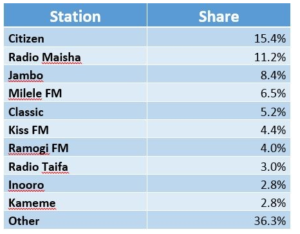The writing has been on the wall for Radio Africa Group for the past two or so years. But it seems the trouble with the company’s management is refusing to follow its own advice.
Things have not been particularly good, with its established radio stations falling in ranking and advertisers moving away to more popular radio stations and new media, while the newspaper has been in reverse gear.
Classic 105, for example has dropped from the top to number five most listened to radio station in the country, while Radio Jambo has gone down from position 2 to 3, after market leader Royal Media Services-run Radio Citizen and Radio Maisha owned by the Standard Group.
According to research commissioned by Radio Africa and seen by BusinessToday, Radio Citizen leads in the national reach ranking with 49% reach, followed by Radio Maisha 42%, Radio Jambo 37%, Milele FM 33%, while Radio Africa’s money-minter Classic FM trails at 30%, followed by Kiss 100 at 26%.
Related >> Star newspaper to be closed down in September
Other radio stations under the group are East FM, Gukena FM and X FM, which have not broken even. Whether the company will retain and prop them to grow, remains to be seen. Radio Africa was the go-to place for radio just a few years ago, with Kiss having a firm grip on urban young population and Classic on the urban general listeners.

But expansions into more radio cannibalised its advertising and audience and may have starved the poor brothers of Classic and Kiss. Or maybe it is the case of biting more than it can chew!
On the other hand, The Star newspaper, which had been positioned as the flagship brand of Radio Africa Group to take over from Classic 105, is the hardest hit. Insiders say circulation has tanked, touching lows of 8,ooo on bad days from over 20,000 copies daily during its heyday. When it started as Nairobi Star in 2007, it was branded as a tabloid, modelled alongside successful such papers in the UK like The Sun.
See Also >> The Star relaunches into a political newspaper
But after two years in the market, the tabloid approach had not struck a chord with Kenyans, forcing the first rebrand of the newspaper. Nairobi Star gave way to The Star in 2009, and the editorial policy was relaxed to give prominence to big stories of the day, although it retained a bit of tabloid-ness by spinning stories.
Numbers started growing, and gyrated between 15,000 and 201,000 per day, not bad for a newspaper barely a decade old. Then in March 2016, The Star was relaunched yet again under a converged newsroom and prioritized breaking stories online. The most interesting aspect of the relaunch, however, was the shift from the free-style tabloid-like publication to a more serious focus on politics, understandably to ride the wave of the general election slated for August 2017. Elections are a big deal for media houses, especially newspapers which often see it as a season to increase circulation and advertising.
That turned out to be a big mistake, though. First the new design, while appealing, reduced the number of articles the newspaper could carry on a page. The slant toward more politics affected the general coverage of issues, with some beats missing out completely. Readers reacted indifferently even as top managers and editors gave a rosy picture of the relaunch. Ever since, circulation has nosedived and circulation shrank.
See Also >> Sacking with a human touch? How Radio Africa did it
Yet still, the company has been shooting itself in the foot. First, even with its lowest circulation among the dailies, The Star charges more or less same advertising rates as its bigger rivals, Nation and Standard. This has scared away advertisers who prefer putting their ads where they are assured of highest number eyeballs. Secondly, the company introduced a cash-on-delivery policy for advertising. It always insisted on payment first before an advert runs, in the process pushing away agencies, big companies and government who operate on credit terms when it comes to advertising.
The introduction of a free newspaper by Mediamax Ltd, which runs the People Daily, also dealt a blow to the Star. PD and Star played in the same league, targeting similar demographics. When it went free, it chocked off a big chunk of readers who are comfortable having the free paper. Notably, the People Daily has been attracting more advertising than the Star.
By kicking some of its key journalists, it appears the Star is out to cut down on the print business and could likely go online, like Nation Media Group did with Nairobi News, closing the print in favour of online.
[crp]












Leave a comment